A Sadhya of Lessons: My Digital Literacy Narrative
- Ananyaa Joy Nair

- Sep 30, 2022
- 14 min read
Updated: Oct 9, 2022

Who am I? It’s a somewhat cliché question that is supposed to make one introspect, consider their presence in the world, and ponder the meaning of life. Although I haven’t spent a lot of time deliberately contemplating my answer to this question, I have started to understand the meaning of its value in recent times. When I was first tasked with creating my digital literacy narrative for my university's internship course, I started to think more about who I am in the context of my journey as a learner. I wondered what the key moments have been in my story thus far and how they have shaped me into the person I am today.
A digital literacy narrative is a representation of one's journey through learning and communication, which includes reading and writing. There are countless ways to tell this story and you can find many examples on the Digital Archive of Literacy Narratives. Whether it be learning the nuances of language or understanding how to express myself through writing and art, I understood that the diverse experiences in my life have heavily influenced my literacy journey. Through my blog, I have tried to capture some of the literary adventures I have had in my life so far. However, since my blog is relatively new and still being built, there are many aspects of my journey that I have not gotten a chance to cover. In this reflective post, I hope to dive into my digital literacy narrative through the lens of one of my greatest pleasures - the sadhya.
Life’s a Sadhya

Sadhya. Source.
Sadhyas have always been a part of some of my most favorite memories. A sadhya is a predominantly vegetarian meal served on a banana leaf comprising several traditional dishes from the state of Kerala, where I am from. Sadhyas can have upwards of 20 dishes and cover all kinds of flavors ranging from sweet and sour to spicy or mild. Its layers of flavors make it an utterly satisfying experience - there’s something for everyone. In my eyes, a sadhya is more of an emotion than it is a meal. Considering that sadhyas usually are served during celebrations and festivals, it is associated with the joy and togetherness surrounding moments with loved ones. From birthdays to Onams, there have been several moments of enjoying sadhyas etched in my memory.
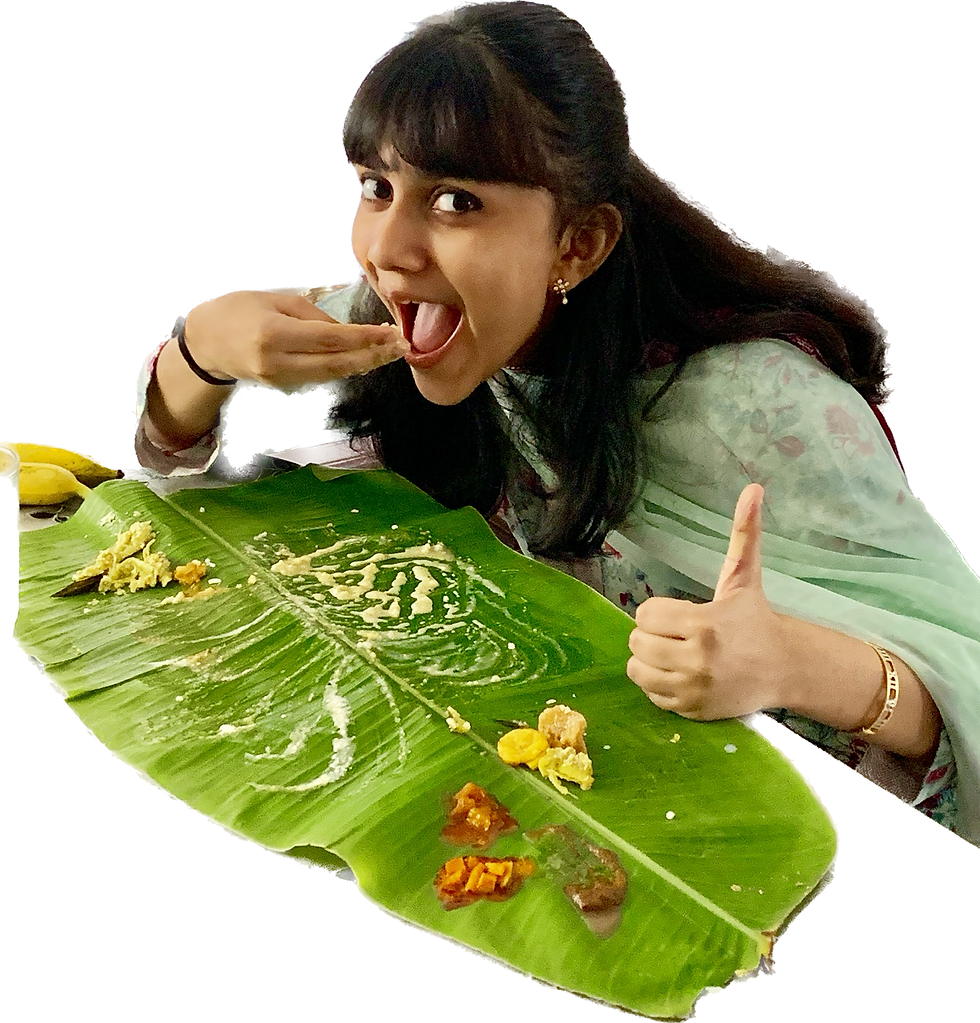
Me and my classic post-sadhya pose
So, what does a sadhya have to do with my literacy narrative? That’s a good question. In order to answer it, I think it’s important to first understand what literacy truly means. Although literacy is defined as the ability to read and write, it actually is better described as an all-encompassing journey of learning and communicating. That’s what I hope to highlight in my literacy narrative. In fact, this idea is central to making the connection between my literacy narrative and a sadhya. Just like a sadhya filled with an assortment of flavors, my literacy narrative is also filled with diverse experiences that have shaped my evolution as a learner and individual. As you read on, you will see the names of some items you will find in a sadhya. Each dish has a character of its own and its flavors can express ideas. Although they might not all be the most important dishes in a sadhya, they communicate some of the key aspects of my literacy narrative.
Avial

Avial. Source.
Avial is a dish made with several vegetables cooked in a thick coconut and yogurt-based sauce. Its main characteristic is that it’s an amalgamation of a lot of things, instead of having just one star of the show. To be honest, avial is usually not my most favorite part of a sadhya. Besides that, in a local context, when people say something is like an avial, they usually mean it is a mishmash. However, I would like to put my own spin on what avial means in my literacy narrative. Similar to an avial, I also have several aspects to my life that’s contributed to my learning and communication style. From living across five countries over the span of my childhood to being bilingual, there are a variety of influences that have taken an important role in my growth.
Moving between locations didn’t just mean geographical changes. It also fuels cultural changes. From authentic Chinese and South Korean food to Malaysian customs, there are many things I’ve experienced and learned on a deeper level through these moves. In turn, I strongly believe these factors have affected my perception of language and communication. When you live in places where the vast majority of people do not speak the same language as you, you begin to realize that language isn’t just about using or understanding letters or words. There are globally applicable aspects to it like emotions, tone, facial expressions, and body language. These transcend borders and must be treated as key elements when connecting with people regardless of their language. Since I imbibed this idea very early on in my life, I have used it to build cross-cultural communication skills that have been essential in my journey of navigating life.
On a more personal note, I think there is a duality that exists within me by being a native Malayalam speaker while also communicating in English. Although being bilingual isn’t a big deal these days (most people know more than one language), I definitely think it affects your communication style and learning as a whole. Considering that my father grew up in the U.S. and didn’t speak much Malayalam, my mother made it a point to ensure that even though I wasn’t living in Kerala all the time, I should be fluent in the language. Having an American passport doesn’t take away the fact that I am a true-blue Malayalee at heart. In my mother's eyes, the language, Malayalam, isn’t just a mode of communication. It is a key part of keeping me rooted in our culture without feeling disconnected to the places and people that are important in my life. Taking this into account, I started learning English and Malayalam side-by-side as a child. Hence, the two cultures associated with Malayalam and English also coexisted in my world, similar to how so many characteristically different vegetables (carrots, cucumbers, drumsticks, raw plantain, etc.) coexist in an avial.
Besides the cultural aspect, I think being bilingual also affects cognition to a certain degree. Malayalam is a language that does not have many visual or auditory similarities to English. For the same reason, I believe that switching between languages involves pivoting between thinking styles as well. This affects communication styles in each language as well, creating unique perspectives. For example, when I speak in Malayalam, I often am more conscious of my intonations than in English, as the pitch used for any given word could have several meanings. I also grew up watching a lot of Malayalam movies in addition to English ones, meaning that my creative references were varied as well. In such ways, I believe I have cultivated a unique outlook on the world around me through a multicultural lens. An avial is a dish that I like to think has a solid foundation despite basing itself on several different characters. I believe that the foundation of my literacy narrative is similar to this in nature - a wholesome avial of cultures.
Injipuli
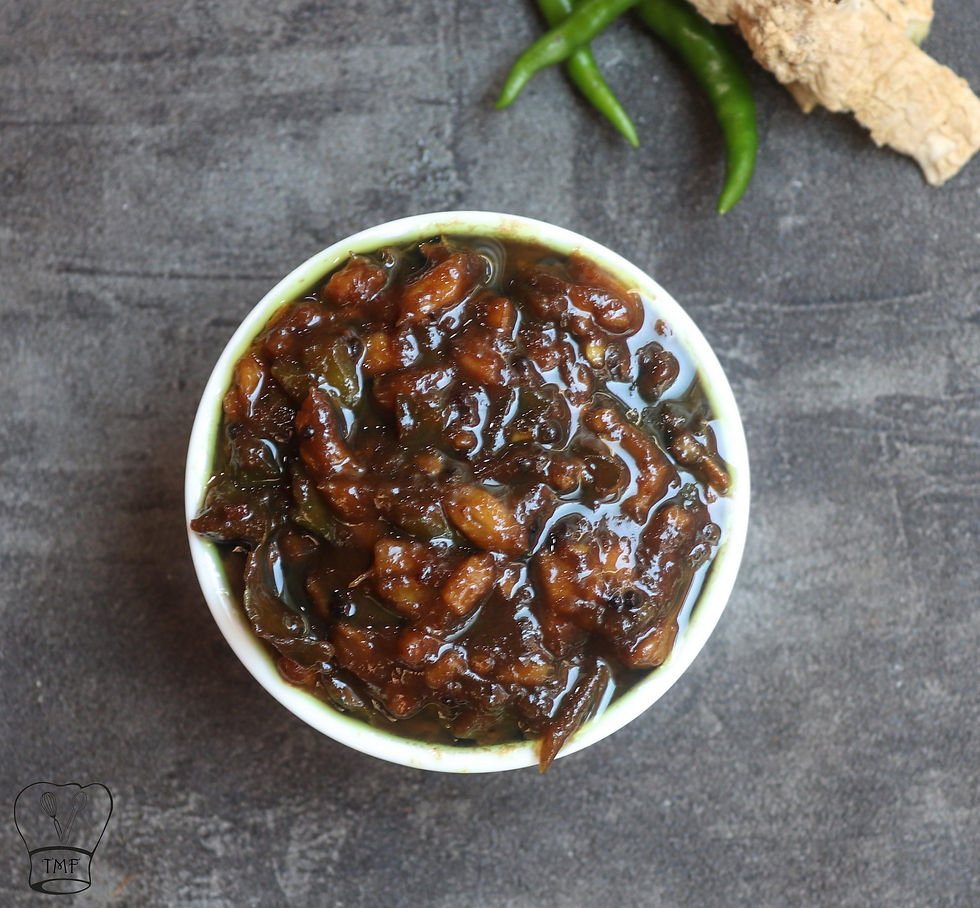
Inji Puli. Source.
Injipuli is a dish made with two key ingredients: “inji” meaning ginger and “puli” meaning tamarind. As you can imagine from hearing this, it is a very strongly flavored dish. In fact, the concoction takes form in a dark brown (almost black) gravy. Does it look like the most appetizing dish at first glance? No. But, injipuli has a large fan following from the people who’ve given it a shot. It may be hard to understand injipuli at first, but eventually, it is understood that it has its own benefits, including being healthy and good for digestion.
Now, where does injipuli fall into my literacy narrative? Well, the best example I can think of that embodies the classic injipuli qualities is my first interaction with the works of Shakespeare. From The Tempest to Macbeth, I have read most of the popular plays by Shakespeare. Although they are most definitely some of the most impressive literary works in existence, I would be lying if I said that I understood all of them at first. In fact, I remember reading through the acts of The Tempest, my first Shakespearean play, in sixth grade and feeling completely lost. Deciphering the intricate and archaic language seemed like a Herculean task. I wondered why people loved reading Shakespeare’s plays all these years later when the language doesn’t hold relevance anymore. Then, over time, I started to appreciate it by focusing less on Shakespeare’s vocabulary and more on the content and meaning of the plays. In order to do this, I used modern translations to aid my understanding. Once I started doing this, I understood what an amazing writer Shakespeare was. I was able to feel the plays like the members of his audience in The Globe Theater rather than just read them.
Through this experience, I realized that it’s important not to judge something based on how it looks. Just like it’s irrational to judge injipuli based on its color or strong flavor, I learned that making a genuine effort to understand Shakespeare’s plays rather than simply reading them is a truly worthwhile experience. I believe that this lesson is so important to consider as a learner and communicator, as it opens the doors to endless opportunities.
Pazham
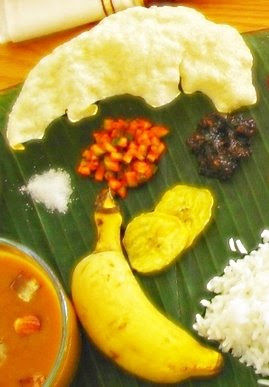
Pazham in a sadhya. Source.
The pazham is a sadhya staple that doesn’t require a complex translation to English. It’s a banana. On the left end of the sadhya’s banana leaf, you will find a small unopened ripe banana along with some other crunchy accompaniments like traditional chips. They are meant to complement the rest of the dishes of the sadhya to balance out all the flavors and textures. Banana lovers never fail to peel their banana and eat it at some point on their navigation of the sadhya. In addition, banana lovers will be the first to say that the pazham actually holds some benefits that are ignored. Some think it’s a great accompaniment to payasam (a sweet dish - more on that later) while others like to use it to clear their palette at the end of the heavy meal. However, there are many people, like me, who fail to even acknowledge its existence. To be honest, I cannot think of a single time when I actually ate the banana. It’s not that I don’t like bananas but when seated in front of such a vast array of delicacies, the banana just seems less important and unnecessary. In fact, most of the time, I give my banana to someone near me who likes them or even worse, I just use it like a paperweight on my folded banana leaf at the end of my sadhya. It’s hard for me to think of a more undervalued member of the sadhya family.
I think the pazham in my literacy narrative would be sentence diagrams. For anyone who is not familiar with sentence diagrams, they are a visual representation of the construction of a sentence using grammar conventions. Different branches on the diagram account for aspects of the written language like nouns, verbs, adjectives, adverbs, prepositions, and so on. Here’s an example of what one looks like.

An example of a sentence diagram. Source.
In middle school, I had to spend hours and hours drawing sentence diagrams for grammar classes. I didn’t really enjoy it. In fact, I would yearn for the day when I could be in an English class where I would have complete freedom to just write essays versus dissecting grammatical information. However, as the years passed and I got to choose how I spent my time writing, I understood that the seemingly redundant sentence diagrams were actually helpful. The repetitive process of constructing and deconstructing sentences emphasized the main ideas surrounding grammar, making it seem like second nature. So, by the time I reached a point where grammar was no longer a part of my English class, I was well-equipped to write essays in a short period of time with high grammatical accuracy. Similar to the pazham that can go ignored but could actually hold value, sentence diagrams were not as unimportant as I thought they were! This lesson taught me that details like grammar are the building blocks of a language and even though communication isn’t solely based on it, it’s valuable to build a strong foundation before taking on more complex projects.
Rasam + Moru = Yum

Rasam. Source.
Rasam and moru are two separate dishes in a sadhya. Rasam is a tangy and spicy liquid that is of deep orange color, while moru is essentially spicy white buttermilk. They are usually served separately. However, my grandfather had a unique way of consuming them by mixing the two together in a glass and drinking it. At first, I used to be confused as to why one would want to do that. It also looks visually unusual considering how the orange rasam and white moru mix to create a peachy shade. Also, since moru is made with yogurt, mixing it with rasam doesn’t create a smooth textured liquid. Initially, the mixture doesn’t seem like the most pleasing drink. However, upon encouragement to try it out, I mixed my rasam and moru one day. It was unexpected but I actually enjoyed it! I felt like a scientist in a lab mixing solutions, really proving that experimentation is the secret to new discoveries.

Moru. Source.
I think my literacy journey went through a peak phase of experimentation during my high school years. With the newfound freedom of Honors and AP-level English classes, I was able to see myself less as a student and more as a writer. Although the structure of writing prompts, homework, and exams still existed, I was able to develop a personal writing style and voice that was unique to me. There wasn’t a right or wrong thesis statement. Instead, the focus was placed on the craft and delivery. Similar to mixing rasam and moru, I was able to experiment with the flavors of writing in different genres and tones. Some of these experiments worked and gave me the satisfaction of a glass of rasam and moru, while others proved to be learning experiences that pushed me to move in a different direction. Either way, I learned that with every experiment, I was one step closer to discovering myself as a communicator.
Olan
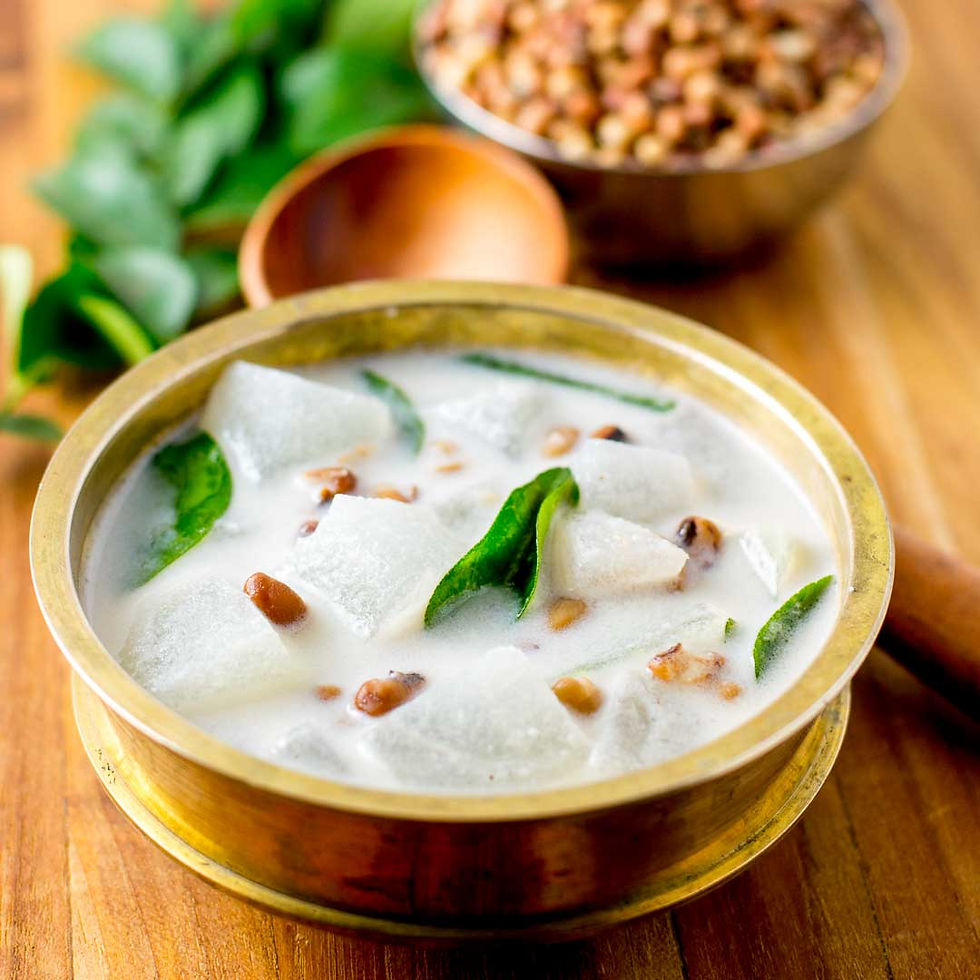
Olan. Source.
Olan is a dish that makes me think of my mom, or Amma as I call her. Amma loves olan and we often disagree on whether it’s a favorite sadhya dish or not. Being someone who does not like too many bland flavors, I usually don’t get too excited about eating olan all the time. However, once I started thinking about it a bit more, olan has more depth and meaning than I once thought. Olan is a subtly flavored dish made with coconut milk, black-eyed peas, and ash gourd. It holds a key purpose in the sadhya landscape. Since most of the other dishes are strong in nature, olan helps balance out the flavors by being mellow. I would characterize olan as the meditation/mindfulness guru of the sadhya, offering a sense of peace and calmness in an otherwise vibrant environment bursting with flavor.
The part of my literacy narrative that reminds me of olan the most is the idea of journaling thoughts to relieve stress and simplify complexity. Although I am not a meticulous journal keeper, I like to turn to writing as a way of relaxing and reflecting (kind of like what I am doing right now). I find writing down my reflections to give me the same effect as what olan has on a sadhya. Usually, I’m writing with an academic or professional purpose in mind, meaning that the process is very structured in nature. However, when I write reflectively, I feel more mindful of the events and people in my life and find myself more at peace. One example of this is when I wrote a tribute for my grandfather earlier this year (you can read it here). Concepts like grief can be hard to cope with but I feel that reflective writing can be a meditative practice that can help overcome such situations. Sometimes, you need the soothing flavor of olan in your life to refresh yourself and move on to more exciting adventures. This idea has been a vital part of my literacy journey and how I view communication.
Payasam
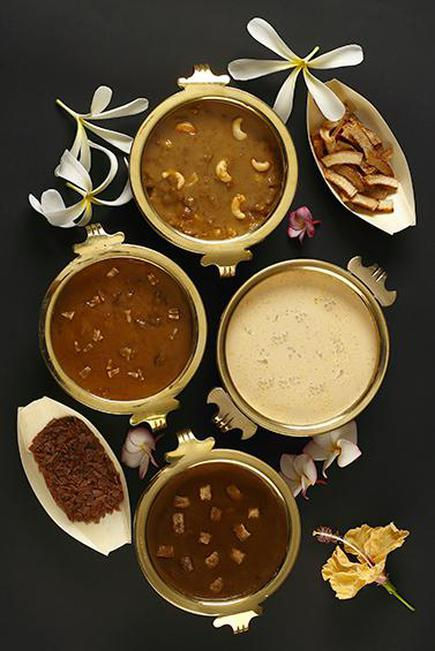
Payasams. Source.
Payasam is a dessert that is one of the crowning glories of the sadhya experience. It is a sweet pudding made with rich ingredients like milk, sugar, nuts, and other items, depending on the variation served. Oftentimes, a sadhya includes more than one payasam. The sweet flavor brings joy and satisfaction to the meal. Similar to payasam, I believe that the accolades and validation I’ve received as a writer and learner have added to my literacy narrative in a positive way. When in moderation, the sweet taste of success can be a reason to keep working hard.

An achievement in my journey as a writer
One moment I felt this was when I won an award for a critical essay I wrote titled “Degrees of Success: Redefining College Ambition” in 2020. It was a project I took on by choice and one that I was passionate about. Receiving a National Silver Medal from the Scholastic Art & Writing Awards made me understand that doing what you love leads to the best outcomes. In fact, I believe that this is a lesson that can be taken out of the writing context and would still hold true. One thing to keep in mind is to not do something just for the accolades. Eating a sadhya only for the payasam isn’t what is important. It’s the process that matters.
Beetroot Pachadi
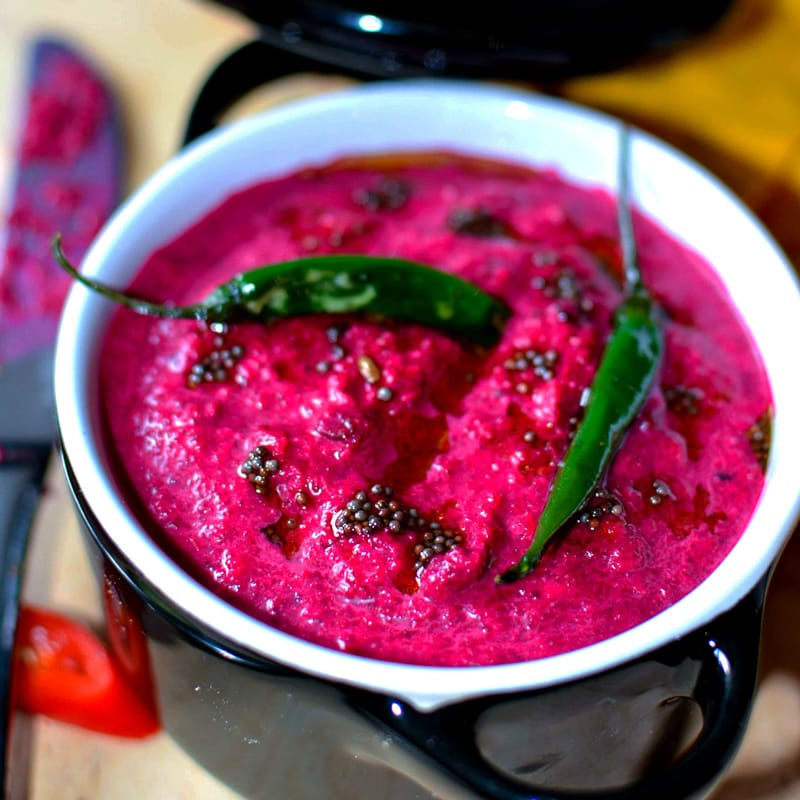
Beetroot pachadi. Source.
You would think that I would wrap up this narrative with a dessert like payasam. However, as I mentioned earlier, I don’t think the accolades are everything. They are just one piece of the puzzle. The dish in a sadhya that I think represents one of the most important lessons/elements of my literacy journey is one that is quite unassuming - the beetroot pachadi. Beetroot pachadi is a dish where beetroots are prepared in a yogurt and coconut-based gravy. It’s got a balance of sweetness, spiciness, and sourness. The highlight of the beetroot pachadi, however, isn’t just its own appearance, but the effect it has on what it comes in contact with. To put it into the context of the social media age, the beetroot pacahdi is the “influencer” in a sadhya. Its striking pink pigment is so powerful that it makes whatever it touches pink also. In fact, when I was a kid (and a picky eater), Amma used to entice me into eating my food quicker by feeding me “pink rice” - a magical creation where beetroot pachadi turns the usual white rice into a beautiful pink color.
When analyzing beetroot pachadi through the lens of my literacy narrative, it becomes clear what the purpose of this journey is. The best part of my literacy narrative is my being able to use my reading, writing, and communication skills to help those around me and, in a way, add color to their lives. Just like how the beetroot pachadi takes its goodness and spreads it to its accompaniments, I have been able to mentor and tutor students who want to take the next step in their own literacy journeys. For the last four years, I have been involved in offering informal teaching to students of all ages. It started in 2018 when I got my first job as part of the Cambridge Mayor’s Youth Summer Employment Program. I worked with children aged 5-12 in Cambridge, MA as they spent their summer participating in activities at the Community Art Center. Reading to them and helping them nurture their artistic abilities was one way I was able to make an impact while also gaining valuable experiences for my own development. Following that, I spent time volunteering at organizations like the Museum of Science in Boston, where I was able to combine my passion for teaching and STEM. I developed skills to communicate with young people and cultivate an interest in science. During the pandemic, I extended this effort to become a volunteer tutor at nonprofits like JuniorCoach (founded by high schoolers) and schoolhouse.world (founded by Sal Khan) to offer free help to students in subjects like math and English. By sharing the knowledge I had with others, I was able to help people who needed help while cementing my own understanding. Tutoring is also a great way to develop communication skills, as content delivery plays a huge role in ensuring learners’ understanding. These were pivotal moments in my literacy journey.

My President's Volunteer Service Award (2021)
Currently, I am continuing to strive to play the role of a beetroot pachadi in the sadhya around me. I recently joined the Aspire Institute as an Alumni and Community Development Intern. Through my work, I am developing my communication skills while helping grow our community of underserved youth who are growing as leaders worldwide. I am able to apply the cross-cultural communication skills I have developed earlier to connect with my team and the leaders from around the world. Outside of my internship, I am also able to apply my knowledge of literacy by being a Writing Mentor at my university. By providing feedback to learners in English classes, I am able to use my voice as a writer to help others find theirs. Overall, I would say that the application of my knowledge to touch the lives of others around me is the finest part of my literacy narrative. It is also the part that I hope to expand on in the years to come.
To Be Continued…
There is no end to one’s literacy narrative just because one has learned how to read and write. Keeping this in mind, I would like to think that my own literacy narrative is a work in progress. As a sadhya is made complete with numerous flavors, I believe that my literacy narrative is filled with multiple emotions and outcomes. Some moments on this journey might be more enjoyable than others. However, just like a sadhya, it's the journey that counts, making all the flavors come together to create a beautiful experience. I am excited to see my literacy narrative continue to take shape as I become a better learner, reader, writer, and communicator in life. This blog is a testament to that effort - one which I hope to nurture as much as possible. With that said, I look forward to enjoying many more sadhyas of lessons - and the food, of course!

A more recent sadhya at home
Comments